What are Playable Ads?
Playable ads offer users an engaging way to interact with mobile apps and games through immersive mini-experiences before making a download decision. They have become increasingly popular as they provide a compelling way to captivate users, improve engagement, and drive higher conversion rates, especially among younger audiences.
In this article, we will explore the concept of playable ads, their benefits, different types, and best practices for implementation.
What Are Playable Ads?
Playable ads are interactive ad units that allow users to experience a mini or demo version of a mobile app or game before deciding to install it. They provide a hands-on preview where users can try out the app’s key features by tapping, swiping, or playing a short game level.
By offering such a “test drive” of the app, playable ads give users a more informed understanding of what to expect, increasing the likelihood of an install. This ad format engages users directly, capturing their attention more than passive formats like banners or videos.
After interacting with the demo, users are presented with a CTA, typically encouraging them to download the app or take another step. Why are they so effective? Their interactive nature leads to higher engagement rates, more qualified leads, and better retention than other ad formats.
Definition of playable ads
If we put it simply, playable ads are an ad format in which the ad allows users to try a small version of the app before they install it.
How are playable ads different from other ad formats?
Playable ads stand out for their high interactivity and user engagement, which leads to more qualified installs and better user retention. If we compare them with other ad formats like banner, video, interstitial, and in-app ads, here are 4 main takeaways:
- Banner ads are less engaging and offer limited screen coverage, making them more suitable for brand awareness rather than driving immediate action.
- Video ads offer rich visual content but lack interactivity, appealing primarily for storytelling or feature showcases.
- Interstitial ads are attention-grabbing with their full-screen format, but they may disrupt the user experience if not timed well.
- In-app ads are designed to blend more seamlessly into the app, offering varying levels of engagement depending on how integrated they are into the app’s functionality.
| Ad fromat | Description | Use case | User engagement and effectiveness |
| Playable ads | Interactive demo or mini-game of an app/game that allows users to try before downloading. | App and game promotions that require hands-on experience. | High–users actively participate by playing or interacting. Leads to qualified installs and better retention. |
| Banner ads | Static or animated ads that appear as a strip or box within the app interface. | Driving brand awareness or small product promotions. | Low–users passively view. Limited engagement and conversion potential. |
| Video ads | Short video clips that auto-play or are user-initiated, often highlighting features of an app/product. | Showcasing visually rich features or storytelling. | Medium–users watch, but interaction is limited to viewing. |
| Interstitial ads | Full-screen static or video ads that appear at natural breaks (e.g., between game levels). | Grabbing attention with a strong visual or message between content. | Medium–captures attention due to full-screen display, but can feel interruptive. |
| In-app ads | Ads that are seamlessly integrated into the app’s user experience (e.g., sponsored content or offers). | Monetizing apps through sponsored offers or subtle promotions. | Varies–can feel natural or forced depending on the implementation. |
The role of interactivity in playable ads
The interactivity element of these ads allows them to engage users and enhance their overall experience.
Users get to participate in a hands-on demonstration of the app or game, which helps them better understand its features and gameplay mechanics. Engaged users are more likely to convert into installs, as they have already tested and enjoyed a part of the app.
Additionally, interactive ads provide valuable insights into user behavior, enabling publishers to optimize future campaigns based on how users engage with the ad.
How Do Playable Ads Work?
Playable ads showcase the app’s most important features or gameplay, encouraging users to engage with the app directly within the ad. Here’s a 5 step breakdown of how they work:
- The process starts with the user interacting with another app, often during natural breaks in the app’s flow, such as between levels in a game or during a pause in activity.
- A playable ad is triggered when the user is not deeply immersed in the app’s main activity. This is important because interrupting the user at the right time ensures they’re more open to engaging with the ad rather than being annoyed by the disruption.
- The ad takes over the entire screen, introducing the user to the advertised app. It typically begins with a short tutorial or introduction that invites the user to interact with a key feature, such as a gameplay sample or a demonstration of how the app works.
- This is the core of the experience. The user actively engages by playing the game or exploring the app’s functionality. The interaction is designed to be intuitive and fun, showcasing the app’s best aspects while ensuring it’s simple enough to engage users quickly.
- After the user finishes interacting with the ad, they are presented with an end card featuring a CTA. This encourages them to take the next step, typically by downloading the app, signing up, or taking another desired action.
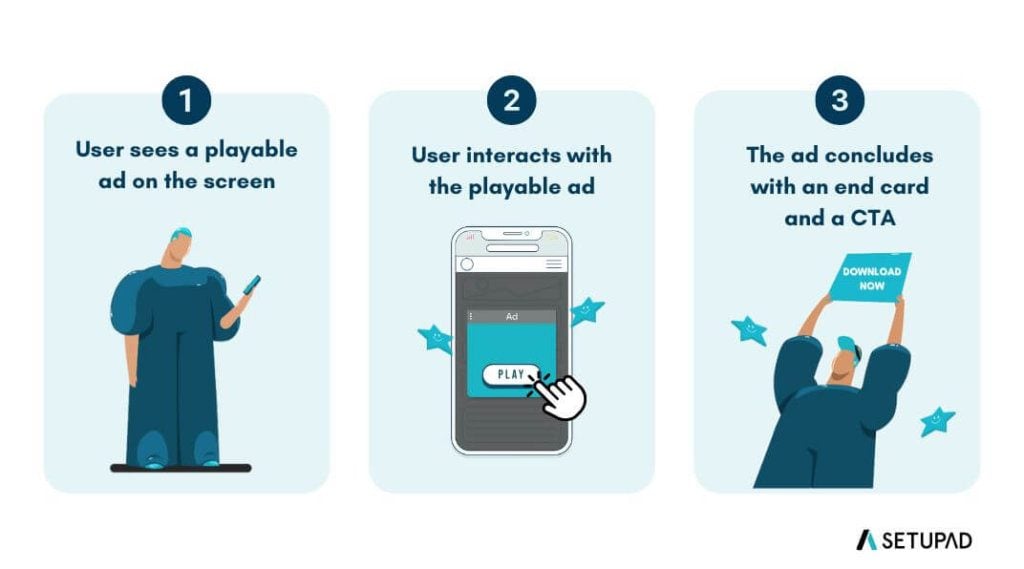
Structure of a playable ad
Playable ads consist of 3 key elements:
- Tutorial or the opening card. This is the hook that draws users into your game. The goal here is to capture attention quickly with a concise and visually engaging introduction. It should clearly and briefly show users how to get started, enticing them to interact without overwhelming them.
- Gameplay experience. This section highlights the core features of your game. Showcase as many gameplay elements as possible, giving users a real sense of your app’s fun and functionality. However, avoid complexity–keep it simple and intuitive to ensure users can immediately jump in. With ad lengths ranging from 15 to 60 seconds, every moment should highlight your game’s best features.
- Closing sequence or end card. This is the crucial moment where you turn interest into action by encouraging users to download your app. A strong, clear call to action is essential, leading users directly to the app store for installation. Ensure the transition is smooth and enticing, reinforcing the value of the game they just experienced.
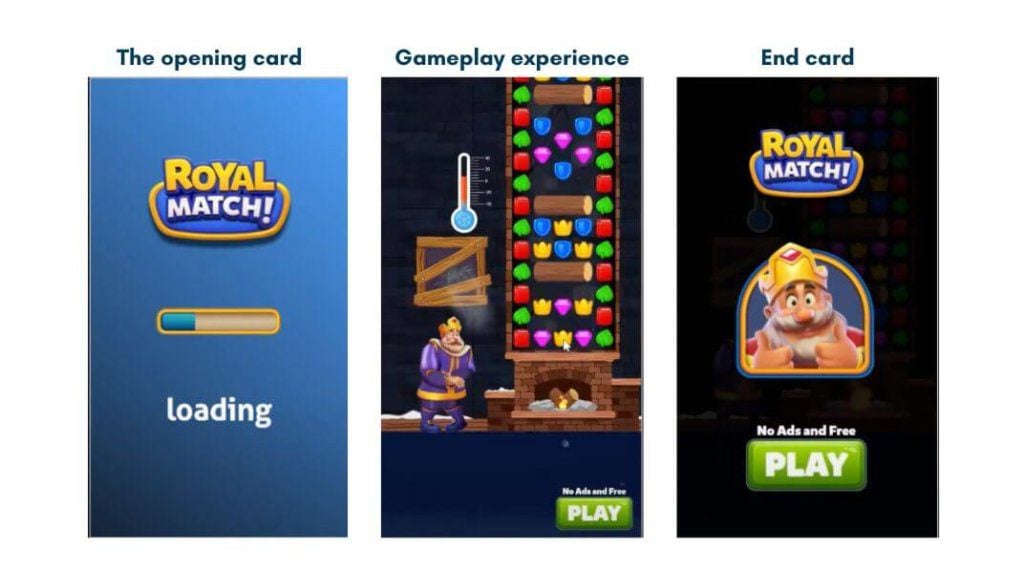
What are the benefits of playable ads for publishers?
So, what makes playable ads so powerful? Here are 6 benefits of playable ads for publishers:
- Playable ads significantly boost user interaction time, averaging over 30 seconds compared to just a few seconds for traditional ad formats. This extended engagement means users are more likely to remember the ad and consider the promoted app.
- These ads have been shown to achieve click rates up to four times higher than standard ads. This increase in clicks translates directly into more app installs and conversions.
- Playable ads provide an interactive experience that allows users to “try before they buy.” This trial aspect helps set realistic expectations about the app, leading to higher satisfaction and lower uninstall rates.
- Publishers can gather valuable first-party data through these ads, such as user preferences and behaviors, which can be used to refine future marketing efforts.
- By fostering deeper engagement and enhancing the user experience, playable ads often lead to better ROI for marketing campaigns, making them a cost-effective solution for driving app installs.
- Playable ads can be integrated into various digital marketing channels, including social media, websites, and in-app environments, providing versatility in how they are deployed.
Types of Playable Ads
HTML5 Playable Ads
HTML5 ads offer a lightweight, interactive experience mimicking core gameplay or app features. These ads are built using HTML5, ensuring fast load times and smooth user engagement across devices.
This format provides a near-native app experience, allowing users to interact with the core functionality without leaving the host app. Given their responsiveness and lightweight structure, they are ideal for high-performance environments and tend to convert better than traditional ad formats.
Unlike other ad formats, HTML5 playable ads allow users to directly engage with the core features of a game or app, offering a “test before download” experience that leads to higher-quality user acquisition and better post-install retention.
Interactive Video Ads
Interactive video ads combine video content with interactive elements. They’re typically easier to create because they repurpose video clips from the app, allowing users to make choices or interact with the video content meaningfully.
While interactive videos can deliver visually rich, cinematic experiences, they may suffer from slower load times and higher data usage than HTML5 ads. They are still highly effective, especially for brands focusing on video-driven storytelling.
The Role of Playable Ads in Different Advertising Ecosystems
Mobile Game Advertising
Playable ads allow users to experience a mini-version of the game, significantly enhancing engagement and improving conversion rates. These ads often serve as immersive full-screen interstitials that showcase gameplay mechanics and align closely with user expectations.
So, why are they perfect for the mobile game industry?
Playable ads allow potential users to experience the game’s core mechanics interactively and engagingly before making a download decision. This approach significantly enhances user acquisition by filtering for genuinely interested players, which leads to higher conversion rates and better retention. Since mobile games often rely on captivating gameplay to hook users, playable ads showcase these elements directly.
Playable Ads on Social Media
On social media, platforms like Facebook and Google have embraced playable ads due to their interactive nature, leading to higher engagement than traditional formats.
Facebook Playable Ads
Facebook playable ads are an interactive format designed to give users a “try before you buy” experience for mobile apps. These ads enable potential users to preview the app through an engaging, interactive demo before downloading it.
Playable ads can appear in various locations on Facebook–the newsfeed, Facebook Stories, and the Audience Network.
Each Facebook playable ad consists of 3 key components:
- Lead-in video. This initial element captures attention in the newsfeed. It often features a short video of the game or app in action and an overlay indicating users can interact with the ad.
- Demo. After tapping the ad, users enter a full-screen interactive demo to engage with the app or game. The demo is designed to be short but informative, showcasing essential features and encouraging interaction.
- Call to action. Finally, a CTA button directs users to download the app after interacting with the demo, streamlining the conversion process.

Playable ads in non-gaming industries
Beyond gaming, non-gaming apps have also recognized the potential of playable ads. Brands in sectors like dating, food delivery, and e-commerce have effectively gamified their offerings, creating interactive experiences that mirror their core functionalities.
For example, transportation apps can simulate requesting rides or managing deliveries, while fitness and wellness apps can showcase tracking workouts or meal planning.
- Lego successfully illustrated the assembly concept through a straightforward gamification strategy, divided into five parts. This approach engaged users with the brand and its promises while they browsed the internet, leading to a memorable and impactful ad campaign. By creating an interactive experience, Lego strengthened its connection with potential customers and showcased its values effectively
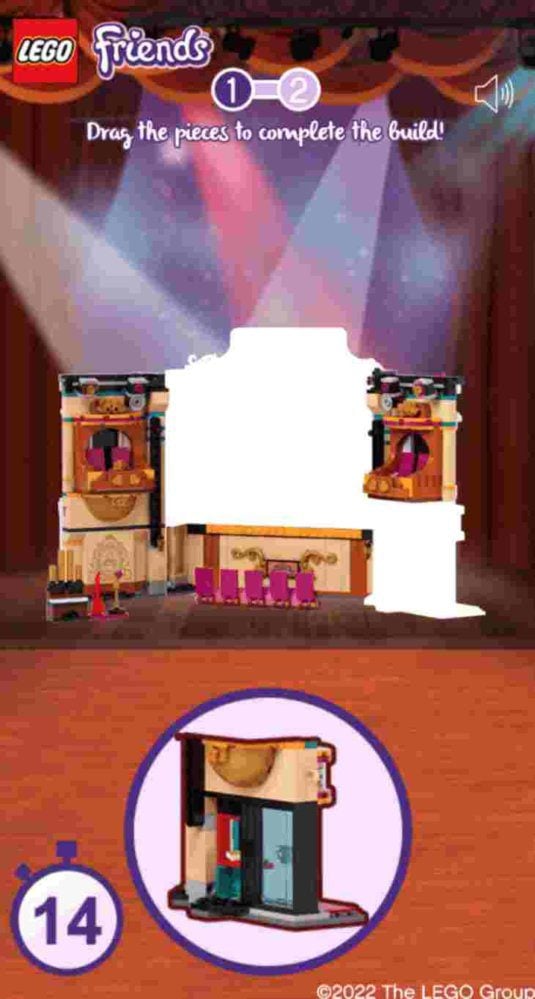
- Maybelline teamed up with Zynga to launch an interactive in-game playable ad titled “Maybelline Mascara Merge”. Developed by Zynga’s Studio E, the game invites players to merge three icons to reveal a Maybelline mascara and earn points.
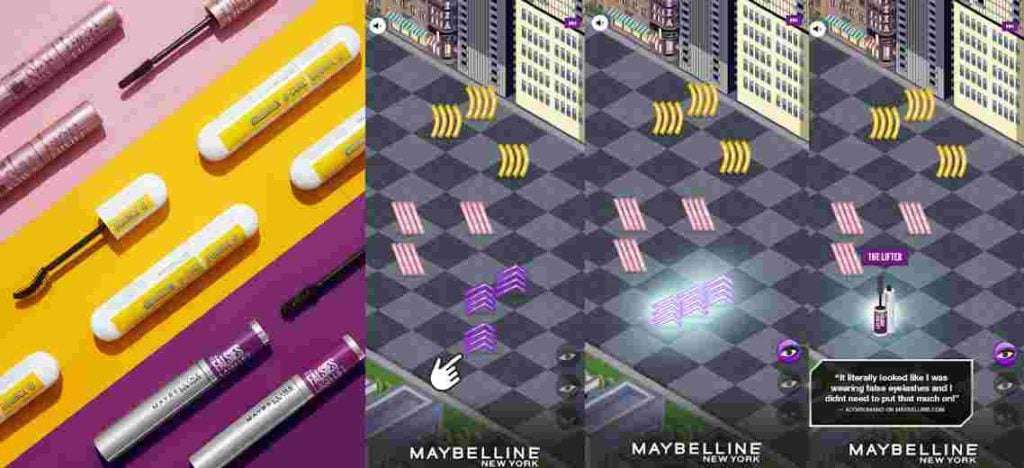
Source: Glossy
By showing rather than telling, playable ads are transforming how brands in various sectors connect with their audience
How to Create High-Performing Playable Ads?
Tools and platforms for playable ad creation
Here are 3 platforms that can assist you in creating effective playable ads:
- Google Web Designer enables users to design and build HTML5 ads and web content through an integrated visual and code interface. With its intuitive design view, you can leverage various drawing tools, text options, and 3D objects to create engaging content. Upon completing your design, Google Web Designer generates clean, human-readable HTML5, CSS3, and JavaScript code, ensuring your projects are visually appealing and optimized for web performance.
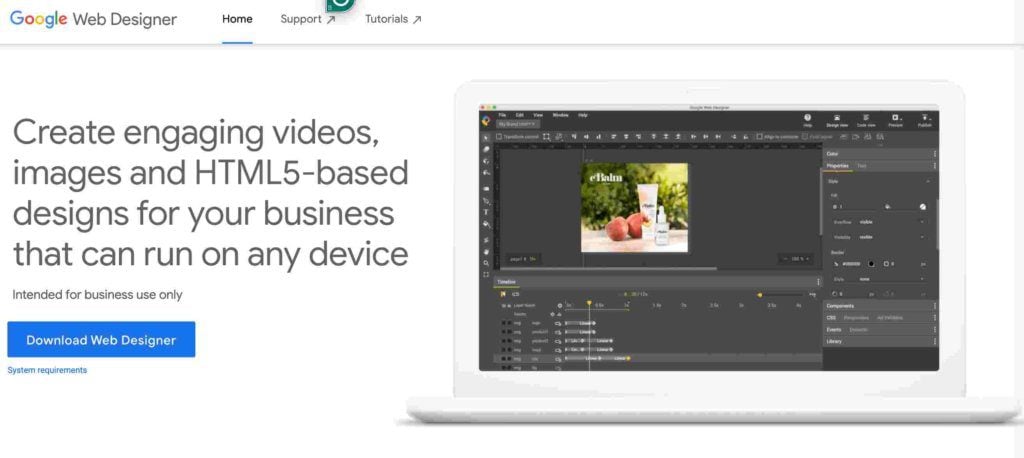
- Unity offers tools for integrating playable ads within games developed on its platform, enabling a seamless advertising experience that leverages its extensive gaming audience.
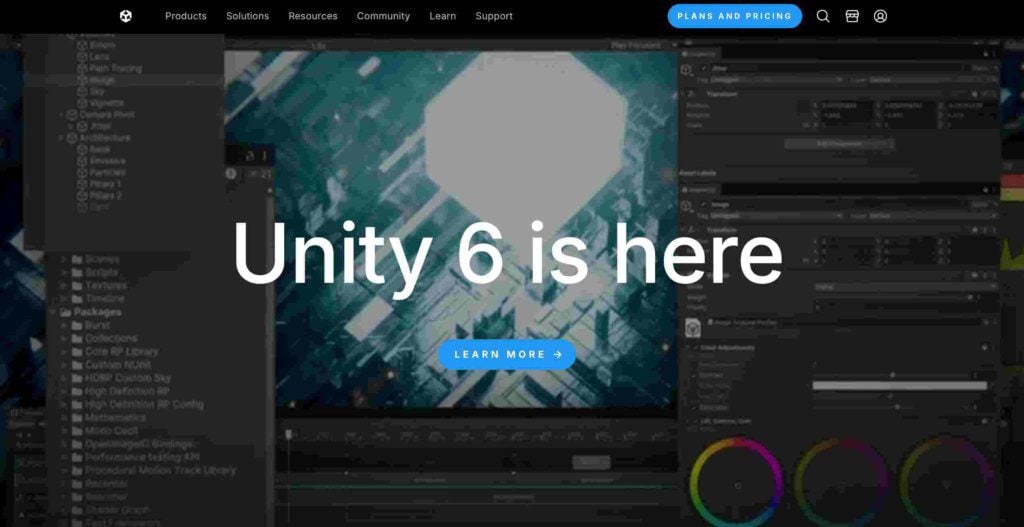
- AdLiven has introduced an AI-powered tool that simplifies creating playable ads. It provides intuitive features that allow users to develop engaging, interactive ads without needing extensive coding skills, making it accessible for a broader range of advertisers.
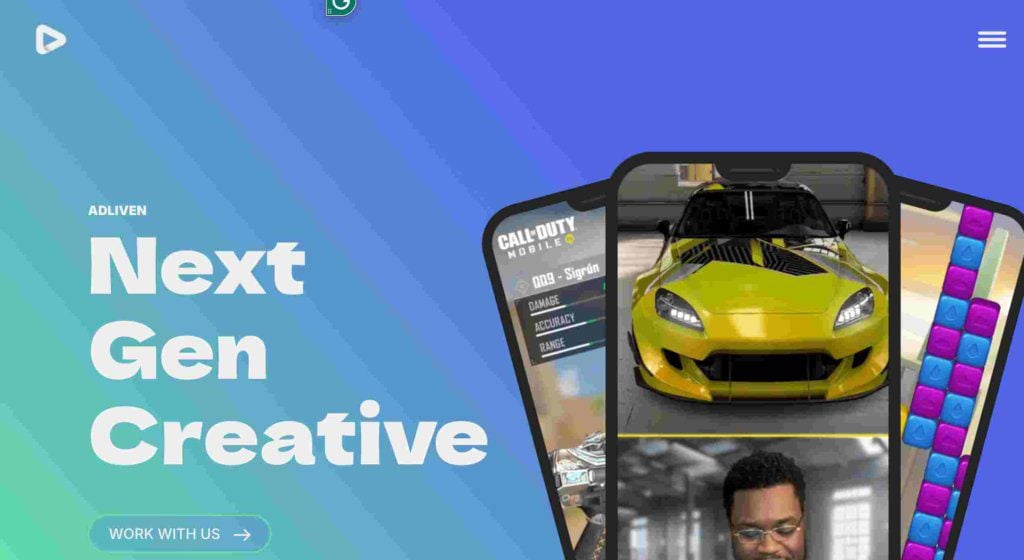
Step-by-Step Guide to Building Playable Ads
Here are the 6 main steps to build playable ads:
- Start by determining what you want to achieve with your playable ad–whether it’s increasing app installs, boosting user engagement, or enhancing brand awareness. Clear objectives will guide your design and development.
- Select the platform where your ads will run. Different platforms like Facebook and TikTok have specific tools and guidelines to assist in creating effective playable ads.
- Develop a prototype that showcases the core features of your app or game. Utilize tools like Unity for this purpose, focusing on delivering a short yet engaging user experience.
- After prototyping, move on to coding the ad’s interactive elements. Ensure it functions smoothly across devices. Remember to break your playable ad into three parts–tutorial prompt, interactive gameplay, and CTA/end card.
- Conduct thorough testing on various devices to identify any bugs or usability issues. Ensure that the difficulty level of the interaction is appropriate to maintain user interest without causing frustration.
- Once testing is complete, launch your playable ad. Monitor its performance metrics to make necessary adjustments and optimize effectiveness.
Best practices for creating playable ads
Keep gameplay short and engaging
Playable ads should offer a concise experience that quickly captures the user’s interest.
Aiming for around 30 seconds allows enough time to introduce key features without overwhelming the player. Highlight the most appealing aspects of the game to entice users to download the full version.
Focus on key features of the product/app
Rather than showcasing every aspect of a game, concentrate on a few standout features that will attract potential players. This strategy is akin to giving an elevator pitch–users should quickly grasp what makes the app exciting.
Optimize load times and performance
Fast load times are crucial for user retention. Playable ads, particularly HTML5 ads, should ideally be under 1 MB to ensure quick loading, providing a smooth and engaging user experience.
Improve the user experience in playable ads
Design the ad intuitively, allowing users to navigate without extensive instructions. A well-structured tutorial within the ad can guide new users while keeping interactions simple and rewarding.
Maintain good visuals and animations
High-quality visuals and engaging animations can significantly enhance the appeal of playable ads. Use eye-catching graphics that reflect the game’s style while ensuring they don’t compromise performance.
Which Publishers Benefit from Playable Ads?
Playable ads are particularly well-suited for publishers of mobile games and interactive apps who want to attract high-quality, engaged users. Thus, playable ads are ideal for publishers who:
- Promote apps with strong gameplay or interactive features.
If your app or game has engaging, interactive elements (e.g., a mobile game with interesting functionalities or a unique user experience), playable ads allow potential users to test and enjoy these features firsthand before installing.
This especially benefits game developers or publishers whose app’s success relies on users experiencing the core gameplay or functionality.
- Focus on acquiring high-quality users.
Playable ads help filter out less interested users, as only those who genuinely enjoy the experience are likely to install. Publishers looking to increase retention rates and lifetime value will benefit because users who install the app after interacting with a playable ad are more likely to continue using it long-term.
- Want to maximize ad spend efficiency.
Playable ads are highly efficient for publishers aiming for a high ROAS. They drive more qualified installs, meaning your ad budget is spent on users who are truly interested in your app. This leads to better conversion rates and higher retention.
- Are looking for ways to simplify complex features.
If your app has rich features that can’t be easily explained in a static or video ad, playable ads are the perfect format to simplify the experience. Users can interact directly with key elements, which is far more impactful than passive formats for apps with in-depth functionality.
Measuring Success in Playable Ads
It’s crucial to A/B test playable ads to ensure they are intuitive and engaging. For example, if the ad is a minigame, the challenge should be balanced, neither easy nor difficult, to keep users interested and motivated to download the app.
Testing variations of gameplay difficulty, visual elements, and the placement of CTAs can help optimize the ad’s performance and improve conversion rates. Key metrics to track include click-to-play/start rates, impressions, and viewing times. They give insight into how compelling your initial hook is and how many users are intrigued enough to engage.
Download conversions, replay rates, and share rates offer insights into how persuasive your message is and the likelihood of users recommending or revisiting the ad.
Conclusion
Playable ads are particularly beneficial as they enhance user engagement, improve conversion rates, and create a more informed purchasing process. By providing a “try-before-you-buy” experience, brands can effectively showcase their product’s core features and functionalities.
Additionally, various types of playable ads, such as HTML5 playable ads and interactive video ads, cater to different marketing needs and can be strategically utilized across multiple platforms.
Publishers promoting mobile games, interactive apps, or complex functionalities, and who want to acquire engaged high-quality users, should prioritize playable ads in their marketing strategy. They are all about user experience, so ensure the ad is clear, memorable, and intuitive to maximize conversions. By focusing on engaging design and simplicity, you can capture attention and encourage users to take further action.
FAQs
What is a playable ad?
A playable ad is an interactive advertisement that allows users to engage with a mini or demo version of a mobile app or game before downloading it. This format enhances user experience by providing a “try-before-you-buy” opportunity.
How do playable ads help in user engagement?
Playable ads significantly increase user engagement by allowing potential customers to interact with the product, leading to longer interaction times and higher click-through rates. Users are more likely to remember and be interested in the brand after an engaging experience.
What are the key elements of a playable ad?
The key elements of a playable ad include an attention-grabbing opening, an engaging gameplay experience, and a clear CTA. These components work together to encourage user interaction and drive app installs.
How can I create high-converting playable ads?
To create high-converting playable ads, focus on delivering a short, engaging gameplay experience that highlights key features of your app while ensuring fast load times. A/B testing different ad formats and interactions can also help optimize performance.
What platforms support playable ads?
Playable ads can be implemented across various platforms, including social media (like Facebook and Instagram), mobile networks, and in-app environments. Popular advertising networks such as Google and Unity also support playable ad formats.
How are Facebook playable ads different from Google playable ads?
Facebook playable ads often feature a lead-in video followed by an interactive demo, tailored for social media engagement, while Google playable ads are integrated within search results and display networks, focusing more on app functionality. Each platform has unique targeting capabilities and ad formats tailored to their audience
How do playable ads affect app downloads and retention?
Playable ads typically lead to higher app download rates due to their interactive nature, as users can evaluate the app before making a commitment. Additionally, because users have prior experience with the app, retention rates tend to improve as expectations are set accurately.
What are the common challenges in creating playable ads?
Common challenges in creating playable ads include ensuring a seamless user experience, managing load times, and maintaining engagement without overwhelming the user with complexity. Additionally, accurately representing the app’s functionality while keeping the ad concise can be tricky.
How can I measure the success of my playable ads?
Success can be measured through various metrics, including engagement rates, click-through rates, conversion rates (downloads), and user feedback. Analyzing these metrics can help refine future ad strategies.
What are the best practices for making a playable ad engaging?
Best practices for creating engaging playable ads include keeping gameplay short and straightforward, emphasizing key features of the app, and ensuring quick load times for a smooth user experience. Incorporating appealing visuals and intuitive interactions also enhances engagement.


